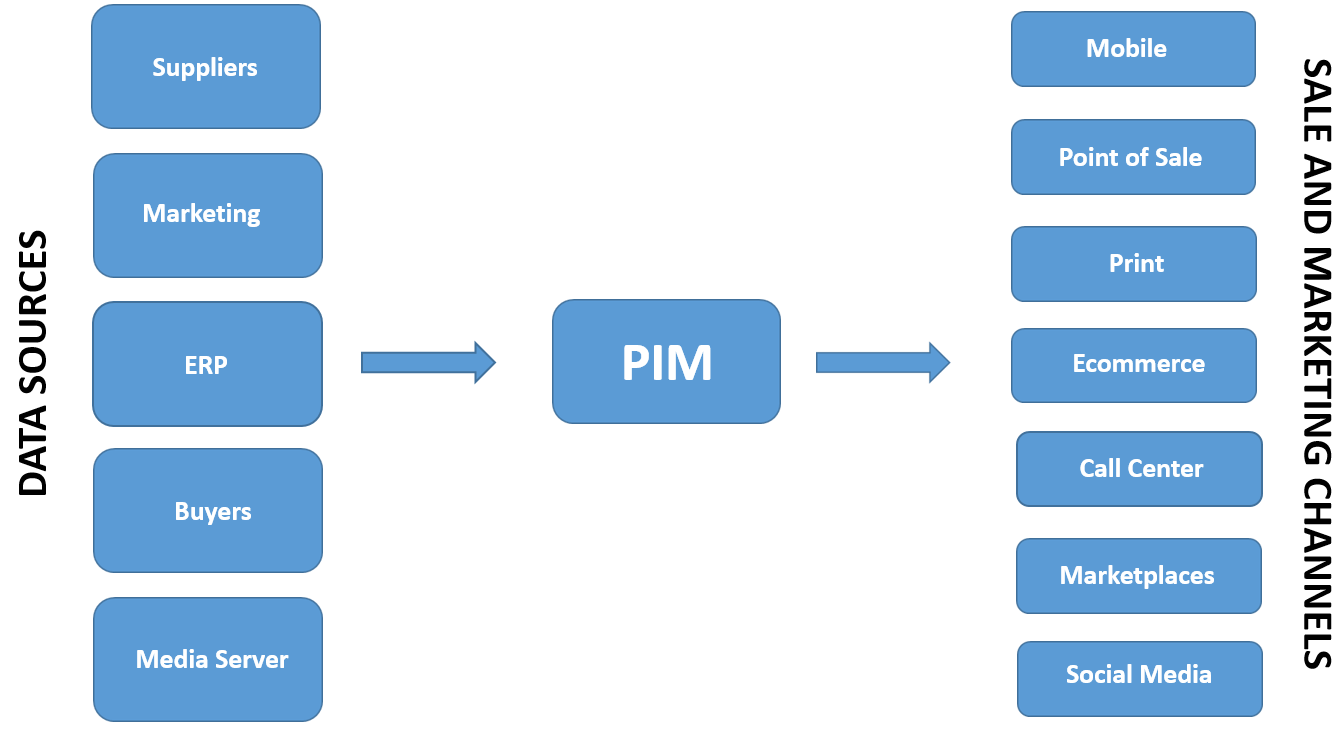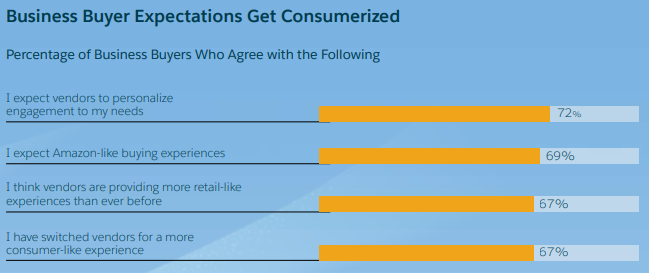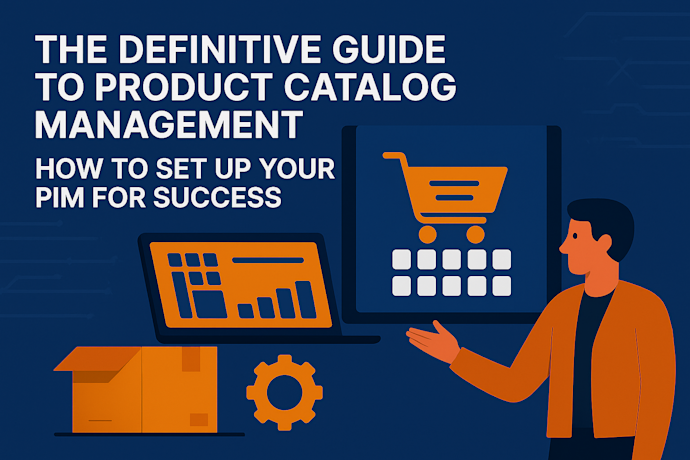
Product Information Management (PIM) software simplifies the subscription and publishing of product information on your marketing and commerce channels.
The way a customer buys a product is determined by interactions with an increasing number of channels along their journey to a sale. The latest channels adopted by B2B companies present opportunities for growth and need dedicated tools to support the swift delivery of accurate product information.
PIM software enables a single place to manage product information as it flows through an organisation. Labour intensive channels such as print catalogues are published far quicker using a PIM while automating product data consistency across marketing and commerce platforms.
Phasing out repetitive, error-prone data enrichment processes in favour of a PIM will speed up time to market while addressing high-level business objectives such as revenue enhancement, agility and compliance.

The Business Benefits of Implementing a Product Information Management System
What are the business benefits of a PIM?
A single B2B sale can be for a large number of configurable items often fulfilled on a limited number of channels such as catalogue and email. Further complexity has arrived with digital channels to serve a generation of buyers who want more of the sales process to happen online. With a PIM the extra margin generated by an increased number of channels will be less impacted by the management of product data.
A PIM structures product data in a central place which not only creates a more efficient workflow but also enables applications like chatbots, voice and recommendation engines that use technologies like A.I. and machine learning. Smart PIMs are built for customisation and third party integration so it can scale with your organisation and business partners globally.
Perfect multi-channel product experience
Multi-channel marketing and commerce relies on information being contextually based on wherever the customer sees your products. Enriching product information with a PIM to create compelling interactions across customer touch points can convert organisational challenges into opportunities for better product experiences.
A single source of truth eliminates duplication and unnecessary silos making it easier to plan and schedule multi-channel publishing. Managed product information workflows are more efficient using a dedicated PIM that can sit neatly between legacy systems like ERP platforms and commerce channels in any digital or print format.
A PIM centralises product information so data sources for customers and internal teams are synchronised eliminating conflicts while promoting sales and marketing alignment. Each channel is an opportunity to deliver a perfect product experience with all its attributes at any point of the product’s lifecycle.
Getting started with a PIM
Fragmented product data with no real ownership is one of the many problems that a PIM can solve.
Identifying data sources and collecting it into one place is the first step to starting a successful PIM project.
Understanding the data available in your organisation will create a clearer picture of the tasks to be completed before data modeling and integration.
Organising product data begins with a methodical review of legacy systems so that data can be cleaned and prepared for migration.
The right PIM will have the necessary customisable tools to deal with different formats that need importing.
First steps: Profiling and cleansing existing product data
- Collect data: Identify usable product information sources
- Format data: Standardise data from origination
- Redundant data: Locate duplicated data stored in multiple places
- Inaccurate data: Correct product data errors and update
- Compliant data: Review data for regulatory compliance
Super efficient enrichment workflow
Manually entering product information using spreadsheets and email is slow. The reason being that it creates unnecessary work to maintain data accuracy. Knowing which versions have being updated and are ready for publishing becomes time consuming and compromises data integrity.
Having one place for product data with clearly defined roles and privileges means that vendors and internal team members can be assigned to manage product information. Tracking product data origination and enrichment through to its intended channel with a PIM significantly speeds up listing products.
A PIM can be easily configured without disrupting existing workflows when expanding into regions with localised product variations and regulatory compliance. Automating translation and notifications for legal verification lowers both workflow friction and barriers into new markets.
When it comes to productivity PIM is a game changer. Suppliers can be more competitive by uploading product information directly into a PIM using your data rules. From data source to customer facing product information the whole process is streamlined resulting in enhanced customer experiences.
Unlimited data modeling using a PIM
Achieving a uniformed level of product information quality while subscribing and publishing data to multiple sources can be done using a PIM. Data modeling enables automation by creating relationships between products. A modern PIM uses object orientated rules with Master Data Management (MDM) functionality.
Products within a PIM are configurable with no limitations. This level of flexibility allows for synonyms to be associated with products so they can be found internally and by customers using words and phrases not normally used to describe them.
Data modeling on a PIM can maintain high level descriptions while updating variable assets across groups without having to manually update each item. By assigning data rules a PIM can automate personalisation with recommended products based on shared characteristics and previous behaviour.
Consumer-like expectations in a B2B world
Online consumer behaviour has shaped the habits of buyers worldwide. In a study by Salesforce 69% of B2B buyers said they expected an Amazon-like buying experience and 67% switched vendors for a more consumer-like experience.
The complexity of a B2B sales process can be fulfilled on consumer channels given the right product information is made available. A PIM helps to maintain and publish channel specific content so customers see consistent information driving higher conversions with fewer returns.

*Image source “State of the Connected Customer” Salesforce Research
Product data enrichment can be automated across outlets as notifications push the correct specifications and formats to each channel. Lowering the friction of publishing content makes it easier to provide customers with innovative product experiences.
ERP, DAM and PLM integrations
Existing data applications will need to be integrated into a PIM in order to continually populate channels such as ecommerce and printed catalogues. Some applications may already be included in a PIM.
In its most basic form a PIM only deals with product information data and doesn’t manage pictures and video. In this case Digital Asset Management (DAM) functionality should be integrated. Some PIMs have this included as a tool to maintain enrichment workflow in one place.
Enterprise Resource Planning System (ERP) contains product information like stock availability, location and price. A PIM can filter and export the data it needs from an ERP to keep product information up to date for marketing and sales content.
A Product Lifecycle Management platform (PLM) manages information related to initial designs through to manufacture, inventory, governance and discontinuation. A PIM can integrate into a company’s PLM to automatically extract relevant description and specification data as it becomes available.
Scaling B2B sales and marketing with a PIM
It’s clear that a PIM speeds up time to market making room for growth with better content designed for expansion into new markets and regions. Ecommerce has been a driving force for B2B digital transformation following the online retail revolution closing the gap between B2C and B2B with expectations for rich product experiences becoming universal.
Marketplaces such as Amazon, eBay and Alibaba are now being used to serve B2B customers. Expanding across borders using platforms wherever your customers already are can be automated to develop previously overlooked channels while minimising costs.
Social media is fasting becoming a primary marketing channel for B2B. PIM allows A/B testing product information simultaneously across platforms such as LinkedIn, Twitter and LinkedIn while keeping a clear view of results for optimisation.
Multi-channel doesn’t necessarily mean existing systems need to be replaced. A PIM is a dedicated tool that enhances tried and tested sales avenues such as printed catalogues and person to person interactions. Serving customers better on their preferred channels whether that be on the phone or with an A.I. powered chatbot is how a PIM can help your business scale.
Stakeholders to consider when choosing a PIM
Reaching out to stakeholders early on will save time and gain support in finding the right PIM for your organisation. Multichannel B2B commerce strives for better conversion rates and customer services while paving the way into untapped markets and geographies.
IT managers and legal stakeholders will be glad to know that a shorter time to market will coincide with enhanced data governance. Marketing managers will welcome automated workflows with a single view of product data enrichment and will be interested in learning more about how a PIM will integrate into third party platforms.
PIMs have a significant and measurable impact on productivity. For catalogue and ecommerce stakeholders this benefit can be felt throughout the organisation. By removing repetitive tasks this not only boosts the accuracy of product data it also gives workers the opportunity to innovate with content giving customers a more engaging product experience on any channel.
Conclusion
A single source of truth with notifications for team members to enhance and publish product content is only part of the PIM story. As with open source platforms like Pimcore your product information can be configured however you need.
This can be done in the cloud or on-premises using an API-led approach enabling a headless content strategy that puts your customer first. With Pimcore all the tools needed to deliver a B2B personalised digital experience are available.
Whether you are streamlining your existing workflows or planning to expand into new markets you can take the first steps to looking more closely at how a PIM can work for your organisation by helping us at Hamari understand your business.
Contact us today with any PIM questions for a speedy reply!
Hamari designs and builds software with complex data across multiple channels. As one of the UK’smost established Pimcore agencies we have a proven track record of helping organisations simplify their product data.


